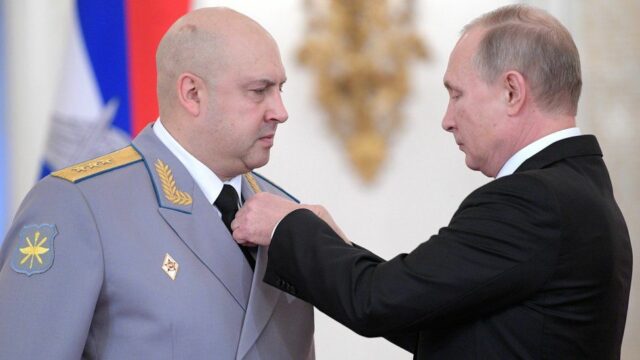
Pariah Armed Forces and Russia’s ‘Party of War’
Publication: Eurasia Daily Monitor Volume: 19 Issue: 151
By:

As the combat situation for Russian forces in Ukraine continues to worsen and as political tensions grow within and around the Kremlin, Ramzan Kadyrov, the head of Chechnya, publicly criticized Colonel General Aleksandr Lapin for the Russian defeat in Lyman. Additionally, Yevgeny Prigozhin, the nominal head of the notorious Wagner Group, supported Kadyrov’s comments publicly (Meduza, October 4). Furthermore, criticism aimed at Russian Minister of Defense Sergei Shoigu is being spread more widely by Russian propagandists, including so-called “war correspondents” and many other pro-war bloggers. Moreover, just one day after his lambasting of Lapin, Kadyrov was awarded the rank of colonel general (TASS, October 5).
It is becoming increasingly more obvious that the Kremlin regularly capitulates in the face of the Russian “party of war,” which is represented by public, and sometimes overemphasized, figures, such as Kadyrov, Prigozhin or even the authors of radical Telegram channels. But perhaps even more consequential, this “party” includes those people who have permanent access to Russian President Vladimir Putin and are directly involved in the Kremlin’s decision-making apparatus. Besides the Russian Security Council, including its staff leaders (Scrf.gov.ru, October 13) and even some members of its academic board (Scrf.gov.ru, May 11, 2021), this “party” presumably includes most of the leadership of the Federal Protective Service (FSO) and Federal Security Service (FSB) together with those who have been appointed to government positions beyond the security services, such as Viktor Zolotov or Aleksey Dyumin. The faction also includes a significant number of other representatives from the Russian political elite, including Andrey Gurulyov, a member of the Russian State Duma and a retired lieutenant general, who has increased his public activity since the beginning of Russia’s aggression against Ukraine in February 2022 (Chita.ru, October 12). Generally speaking, the Russian “party of war” is not a typical ad hoc political coalition nor a structured political hierarchy. Rather, it is an ideologically motivated and consolidated network of people, who believe in the necessity of restoring the Russian Empire and whose remaining power depends on the result of the confrontation with the West. Thus, their goal is as conservative as it is radical: to stay in power at any cost and to destroy the US-led global order that prevents them from staying in power.
The appointment of General Sergei Surovikin—commander-in-chief of the Russian Aerospace Forces with a “hawkish” reputation—as commander of the Russian forces in Ukraine only temporarily eased domestic political tensions and restored some visible consolidation among the different wings of Moscow’s ruling class (RIA Novosti, October 8). However, a recent leak from FSB officers about Russia’s irrecoverable military losses in Ukraine, which now total more than 90,000 soldiers and officers (Istories.media, October 12), as compared to the fabricated official data provided by the Russian Ministry of Defense (Kommersant, September 21), testifies that any notion of complete consolidation is ill-founded. Being consolidated internally, the “party of war” seems to be unable to extend its network.
Meanwhile, Western media is receiving more leaks from Kremlin officials about those within Putin’s inner circle who disagree with his course of action (Reuters, September 14; The Washington Post, October 7, October 13). This process appears to be an attempt by some Moscow insiders to distance themselves from any semblance of personal responsibility for Russia’s aggression in the face of Western political elites and public opinion.
The sabotage on the Kerch Bridge in Crimea aggravated this political faction further, which remains antagonistic to the Kremlin despite the fact that the Russian public’s dominant reaction to the Crimea attack supports a course of further escalation (Fontanka.ru, October 8). Even independent of the “party of war,” the Kremlin has limited opportunities for escalating its aggression in Ukraine. The recent massive Russian missile attacks with the support of Iranian-made loitering munitions against Ukrainian cities did not make much military sense, but the strikes have demonstrated the implications for a “terrorist approach” to the conflict and the alarming deficit of long-range missiles on the Russian side, as it has been unable to replicate the heavy strikes of February 2022. Moreover, Russian citizens at home were the main audience for these attacks, and Putin’s main goals were to maintain his personal image as the supreme commander-in-chief as well as the support of domestic radicals from the “party of war” itself and from the lower levels of Russian society (TASS, October 10).
This degradation of Russia’s military power toward a “terrorist approach” is combining with organizational degradation of the armed forces, which is related to the massive losses in manpower as well as the ongoing problematic mobilization. Consequently, the Russian army faces the threat of transforming itself into an irregular military force, which will pose a greater domestic political threat once these units return home from Ukraine. In this way, both the Kremlin and the “party of war” are interested in continuing aggression until the very end, prolonging the political and combat agony.
However, if Putin’s authoritarian regime hopes to survive this overwhelming turbulence, it will probably attempt to paint the Russian Armed Forces and its leadership, including Surovikin, as the sole actors responsible for the harrowing defeat in Ukraine. For members of the Russian “party of war,” turning the Russian Armed Forces into a pariah institution may be the only way for them to avoid losing significant power in Moscow.



